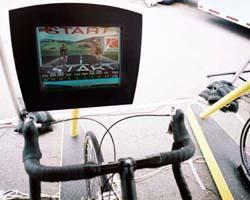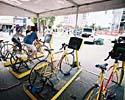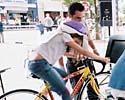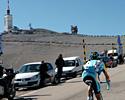
Recently on Cyclingnews.com |
Getting in gear with the Saturn Cyberbike
By Ray Easterling
Got tech? Send press releases, news, and tech questions to the Cyclingnews tech-heads.
 |
If you were in Philadelphia this Sunday to watch the USPRO Championship, you could also have experienced what it is like climbing the infamous Manayunk Wall, just like the pros. Only, you didn't have to go out on the course, the police frown upon that. No, if you wanted to experience riding the Wall, without the possible jail time, you just had to look off to the side of the street. There you would have found the Saturn Cyberbike expo.
"We have four team LeMond Saturn bikes," says Todd Gogulski, Event Operations for Saturn Cyberbike. "They're virtually the same bikes the Saturn pro team races on."
In turn, these bikes are connected to an electronic load generator via the rear wheel. Driven by computer software, this device then provides varying resistance to correspond with the terrain a rider views on the accompanying computer screen. "It's within three percent accuracy of riding on the road," Gogulski says.
Cyberbike is actually an adaptation of the publicly available CompuTrainer software and hardware, but has been modified exclusively for Saturn. And while the Cyberbike simulators make appearances all across the country, the Saturn folks have something special in store for Sunday.
 |
"Part of the software allows you to build corners, straightaways and grades anywhere less than 15 percent up or down," Gogulski says. For Philadelphia, they have programmed in the Manayunk Wall. Gogulski would be in a position to know a thing or two about cycling on grades. He was a pro for 11 years and won the Mt. Evans Hillclimb. Twice.
"I like the charged atmosphere around the racing and the excitement and enthusiasm people have," Gogulski says. "It's something you don't see a lot in the workplace and if you do, you're lucky, but you see it all the time in bike racing."
On site in Philadelphia, Todd and his crew measure the rise of the climb and the associated length to build a cyber-replica for the simulators. Once the climb is programmed into the software, the networked bikes can be used to race solo, two up or with all four riders pitted against one another. Additionally, two of the bikes have been outfitted in order to fit smaller riders and children.
Gogulski and the rest of the Saturn Cyberbike staff tour the United States, putting the Cyberbike simulators on public display in auto shows and at athletic events across the country.
"In general people like it a lot. We have gone over 300 riders on a few busy days, so it is very busy. [At] the auto shows, you get more people who just stumble upon us," Gogulski says. The Saturn staff will announce the races via loudspeaker to "make it as exciting as we can." Prizes are given away for good performances.
 |
"You get some amazingly fast people just that are very strong for the quarter mile," he says. "But once we started going to some of the bike events, we saw some guys throw down some times that we were really impressed with and they can challenge some of the Saturn pros, on occasion."
And, on occasion, they do. Often, the Saturn pro riders are on hand following races in order to chat with the public, announce simulated races and even put the hammer down themselves once in a while. Two to three hundred people can roll through the simulator on a given day, and Gogulski estimates that roughly 10,000 people have tried out Cyberbike since last October.
"It's been great. People love it. The hardest thing frequently is actually shutting down at the end of the day because people want to keep riding," Gogulski says.
For those who missed their chance in Philadelphia, Cyberbike will make its way to the Summer X Games in Los Angeles before wrapping up the season at the San Francisco Grand Prix.
Recent techTour tech: Zipp's slippery
new wheel revealed |

